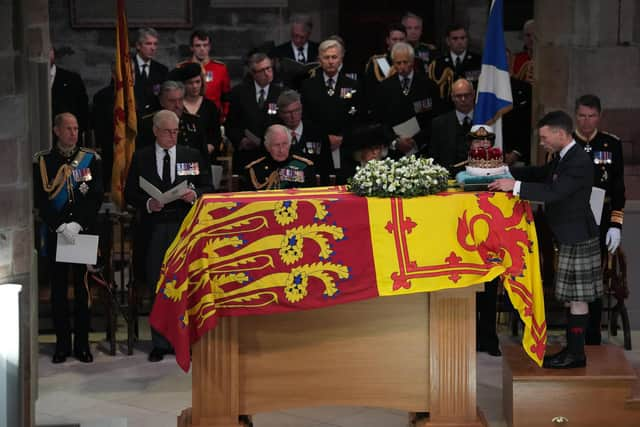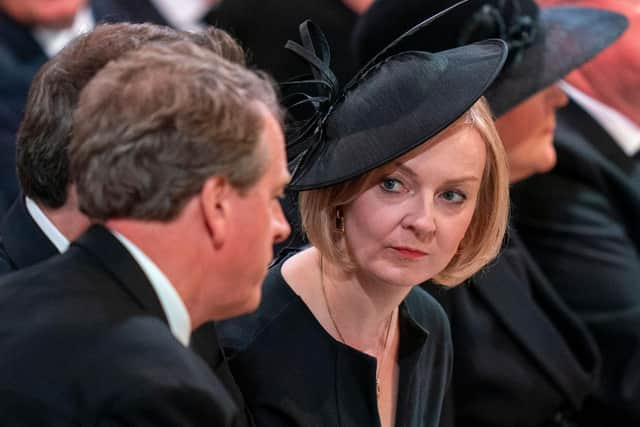Queen Elizabeth II death: Service at St Giles' Cathedral gives thanks for 'extraordinary life' of Her Majesty
Love for a mother, a grandmother, and a great-grandmother, as well as a Queen. The only Queen the vast majority of those in attendance have known.
But so too, there was love for a woman who seemed synonymous with the monarchy itself, and whose extraordinary life and reign reminded generations of its historic and enduring role in the nation’s life, one which predates its legislature, its legal system, and even the Church of Scotland itself.
Advertisement
Hide AdAdvertisement
Hide AdThe hour-long service of thanksgiving for the life of Queen Elizabeth II was, in so many ways, an unprecedented chapter in modern Scottish history.
Where once the firebrand preacher, John Knox, raged at St Giles’ pulpit against the gynarchy and declared the rule of women as contrary to the Bible, the same cathedral mourned the woman who became Britain’s longest-serving monarch.
Where once this ancient place was stripped of its Catholic decorations and statuary, the Most Rev Leo Cushley, Archbishop of St Andrews and Edinburgh, was chosen to read the Epistle.
Where once the market trader, Jenny Geddes, sparked a riot after throwing a stool at the Dean of St Giles’ in fury at his use of an Anglicised prayer book, the congregation fell silent to honour a Queen who also served as Supreme Governor of the Church of England.
Where once the bells of St Giles’ chimed disdainfully to the melody of ‘Why Should I Be So Sad on My Wedding Day?’ to mark the signing of the Act of Union treaty, they rang out in celebration of the monarch who, as an ordinary member of the Kirk, embodied the Union of the Crowns.


At nearly every turn of a solemn, thoughtful and tender service held before a cross-section of Scottish society, history was being made and, in many ways, reconciled.
But at its heart, this was a thank you to Elizabeth II. As Reverend Calum I MacLeod, the minister of St Giles’ Cathedral, said at the service’s outset: “We gather to bid Scotland's farewell to our late monarch, whose life of service to the nation and the world we celebrate, and whose love for Scotland was legendary.”
As the Queen’s coffin was brought into the High Kirk by eight soldiers from the Royal Regiment of Scotland, King Charles III, wearing full day ceremonial uniform with the rank of Field Marshal, walked close behind, side by side with the Queen Consort. They were followed by the Princess Royal, her husband Vice Admiral Sir Tim Laurence, and then the Duke of York, with the Earl and the Countess of Wessex next.
Advertisement
Hide AdAdvertisement
Hide AdThe King looked straight ahead as he passed by, while the choir sang ‘Thou Wilt Keep Him In Perfect Peace, Whose Mind Is Stayed On Thee’.


The coffin was placed on a wooden catafalque as the congregation continued to stand, and the King and his family took their seats.
With that, the hundreds of mourners, whose number included Prime Minister Liz Truss, Gordon Brown and Lord McConnell, began to sing the first of several psalms. All had been sung by Elizabeth II and her family during services at Crathie Kirk near her beloved Balmoral.
A silence fell again as the congregation sat and Rev MacLeod offered poignant prayers, telling the congregation of how it had gathered as a “sorrowing nation,” albeit one that remembered with gratitude the “many gifts and graces” of the late Queen.


What followed was one of the most touching flashpoints for the service, and fitting for the most viscerally Scottish monarch of modern times.
The vaulted ceilings of St Giles’ echoed with Catriona McKay’s harp, as veteran folk singer Karen Matheson sang a spellbinding psalm in Gaelic, the language once persecuted to the point of extinction by James VI.
Some members of the congregation could be seen wiping away tears, perhaps mindful of the resonance of the moment, or simply moved by its unfettered beauty.
First Minister Nicola Sturgeon, dressed in an all-black outfit and black hat, then read Ecclesiastes 3: 1-15, a passage that reminded all in attendance that life is made of joy and sorrow, and there is “a time to be born” and “a time to die”.
Advertisement
Hide AdAdvertisement
Hide AdAfter the choir performed another of the Queen’s favourite psalms, Archbishop Cushley delivered the Epistle. In a sign of the multi-faith nature of the service, the Most Rev Mark Strange, Bishop of Moray, Ross and Caithness, and Primus of the Scottish Episcopal Church, then read the gospel.
In a shift of tone that offered a more reflective mood, the Rt Rev Dr Iain Greenshields, Moderator of the General Assembly of the Church of Scotland, delivered the homily.
His carefully chosen words did not reach for easy sentiments. Instead, he spoke simply and fluently, capturing the mood of those in the cathedral, the crowds listening outside via vast speakers, and the millions watching around the world.
“These last few days, as tributes to Her Majesty have poured in, and we have watched images of her on screen from her earliest years, capturing that remarkable life, yet now beginning to sink in that she is gone from us – ‘gone home’ to express her own words,” he said.
“Today, we gather in this place of worship and throughout the nation, to express our thanks to God, for Her Majesty Queen Elizabeth's extraordinary life.”
Dr Greenshields, who spent days at Balmoral the weekend before Elizabeth II’s death at the age of 96, turned to the King and his family as he spoke.
“We are united in sorrow at the death of our monarch, but we are also so aware that His Majesty King Charles and all his family are not just grieving the loss of their Queen, but their mother, grandmother and great-grandmother,” he explained.
Elizabeth II, he reminded the congregation, was a Queen with an “intelligent mind”, a “kindly heart” and a “gentle sense of humour”, one who began her reign by asking for wisdom, and later adding duty, honour, commitment and faith. “These are the words that we reach out for today,” Dr Greenshields added.
Advertisement
Hide AdAdvertisement
Hide Ad"She was determined to see her work as a form of service to others, and she maintained that steady course until the end of her life.”
As the service neared an end, there were other little moments which spoke of the changing monarchy and the changing church.
Samuel Nwokoro, a Nigerian student, was among those to offer prayers – a reminder of how much the Queen valued the Commonwealth of Nations. And the congregation stood to sing ‘The Bleacher Lass o’ Kelvinhaugh’, a hymn adapted from a folk standard by the late Leith Fisher, a Church of Scotland minister in Glasgow.
With that, all in attendance sang the national anthem, as the royal party made its way back out into West Parliament Square. The King could be seen nodding to some members of the congregation.
Applause could be heard when the royal family stepped out into the Edinburgh sunshine, as some members of the congregation turned to look at Elizabeth II’s coffin, draped with the Royal Standard of Scotland and adorned with the Crown of Scotland. Beside it, four suited members of the Royal Company of Archers, dressed in long-feathered hats and armed with arrows and quivers, stood guard.
Some 69 years have passed since Elizabeth II came to St Giles’ for a celebratory national service of thanksgiving just three weeks after her coronation. Now, she is back, lying at rest, before she is taken to London.
Even on a day so redolent with history, it is hard to believe this is the last goodbye.
Comments
Want to join the conversation? Please or to comment on this article.
